By Keith “Powder” Patton, CDR, USN
Calculating the power of a fleet is a daunting and imprecise task. In the Washington Naval Treaty, tonnage and gun caliber were used as metrics to set the ratio of capital ships between leading world navies. Capital ships were seen as the supreme arbiters of a naval conflict. The London Naval Treaty established similar rules for tonnage and gun caliber for smaller combatants. The United States Navy counts battle force ships, which includes combat logistics forces, toward its end strength. The battle force ship metric is simple hull count, with T-AKE, PC, LCS, DDG and CVN classes all being counted as equals, despite vastly different mission, size, manning, and capabilities. By a simple measure of hull count from 2018-2019 Jane’s Fighting Ships, the USN has 10 percent fewer warships than Russia, and is half the size of China’s fleet.

However, when tonnage is used as the metric, the picture changes dramatically:

This change is unsurprising. The nature of the fleets are significantly different. The USN tends to operate much larger ships optimized for long range power projection. China and Russia have many missile-armed patrol boats and corvettes compared to the relatively few U.S. Cyclone class PC and corvette-like LCSs.
However, does the metric of tonnage truly measure the power of a fleet? The interwar period treaties considered both tonnage and caliber of guns. These two metrics were related, in that larger guns required a larger vessel to carry them. In general, there also was a direct correlation between the caliber of the gun and its destructive power. Tonnage also affected how much armor could be carried to protect against gun hits. Another metric used to compare warship power was broadside throw weight. This was the total mass of shells a ship could deliver in a broadside against an adversary. A heavier broadside could be expected to triumph against less armed opponents. However, in the modern era, guns have been eclipsed by missiles as the primary weapon of naval combat. While battleships carried far more powerful weapons and were relatively immune to the deck guns of small combatants, the same is not true of missiles today. Very similar if not identical anti-ship missiles are carried by small patrol combatants and mounted on the largest combatants, sometimes in identical quantities (eight being a popular number). While the defensive and damage control capabilities of larger vessels may be greater, it still seems likely that a few missile hits will knock most ships out of action, if not sink them. If missiles are the true measure of a fleet’s combat power, then neither tonnage nor hull count is an appropriate metric, because neither is directly related to a ship’s missile capabilities.
For the sake of this analysis, we will borrow Robert O. Work’s concept of battle force missiles (BFM) from his “To Take and Keep the Lead” monograph. BFMs are missiles that “contribute to battle force missions such as area and local air defense, anti-surface warfare, and anti-submarine warfare. Terminal defense SAMs, which protect only the host ship, are not considered a battle force missile.” Thus, weapons like RAM, ESSM, SA-N-9, Mistral, and HHQ-10 point defense SAMs would not count toward the tally of BFM. ASROC, Harpoon, Tomahawk, Standard Missiles and non-U.S. equivalents do count. Generally speaking, BFMs cannot be reloaded at sea, unlike shorter-range defensive missiles. They are too large and unwieldy. As such, they also serve as a cap on the offensive or defensive power a ship can provide. When BFMs are exhausted, the ship must return to a secure friendly port to rearm.
The ship numbers and missile capacity considered below were taken from Jane’s Fighting Ships 2018-2019 as a standard reference. In some cases, there are issues with overlap. For example, some U.S. Mk 41 VLS cells can carry a BFM, or quad-packed ESSM, which would not count. Russian vessels are able to fire SS-N-16 Starfish anti-submarine missiles from their torpedo tubes. While SS-N-16 (like ASROC) would count as a BFM, Jane’s did not have a magazine capacity of how many were carried by Russian warships. So, this BFM-launched via surface ship torpedo tube was ignored. Submarine heavy weight torpedoes were counted. While they may not be missiles, they are a primary anti-surface warfare weapon and, in some subs, are interchangeable with BFMs for strike or anti-ship missions. Finally, there was not complete data for all classes (e.g. number of torpedoes carried), so data was extrapolated from similar designs. The results of this BFM count are in the chart below.
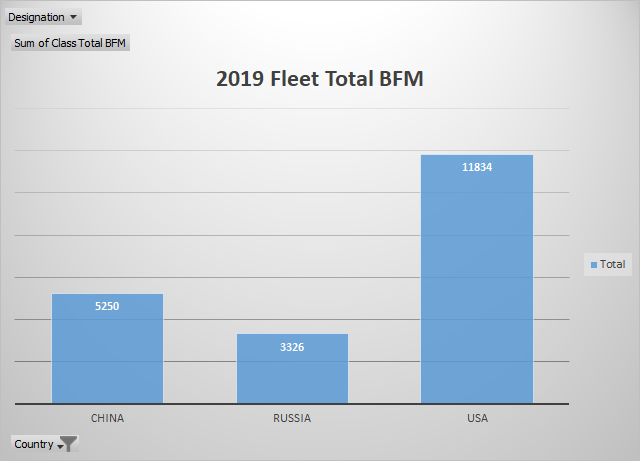
This accounting of fleet firepower shows the USN has more than twice the BFM of the Chinese PLAN. The gap is even larger if the contribution of carrier-born aircraft is considered. The U.S. has an almost twenty-fold advantage in fixed-wing aircraft operating from ships. Carrier-born aircraft, especially from CATOBAR carriers, can carry multiple BFM and can reload aboard the carrier. In addition, the carrier can have its magazines reloaded at sea, something other ships cannot do with their BFMs. However, it is worth noting that China’s BFM count gained over 1000 missiles since 2017, and the U.S. number has been relatively static.
Using BFM as a fleet metric also allows for different ship sizes. A U.S. Flight IIA Burke class DDG with 96 VLS tubes provides the same BFM capacity as 12 patrol boats with 8 missiles each. Who would win in such an engagement would probably hinge on who had better intelligence, surveillance, and reconnaissance (ISR) support to target the other first. However, twelve patrol boats also have the advantage of being able to be in multiple places at once and needing at least 12 hits to defeat – far more than the Burke could likely endure. Continuing with Robert Work’s characterization, we can classify ships by their BFM count. Currently, warships have classifications of cruiser, destroyer, frigate, corvette or similar based more on politics than clear distinctions. What Work recommended was similar to the old system of classifying ships by guns. In this case, missiles instead of guns. First-rate warships (>100 BFM), second-rate (90-100 BFM), third-rate (60-89), and on down to unrated warships with negligible missile capability. For this analysis, the author augmented Work’s lower ratings with fourth-rate (40-59 BFM), fifth-rate (20-39 BFM), sixth-rate (6-19 BFM), and unrated as < 6 BFM. This reclassification produces the following fresh perspective:
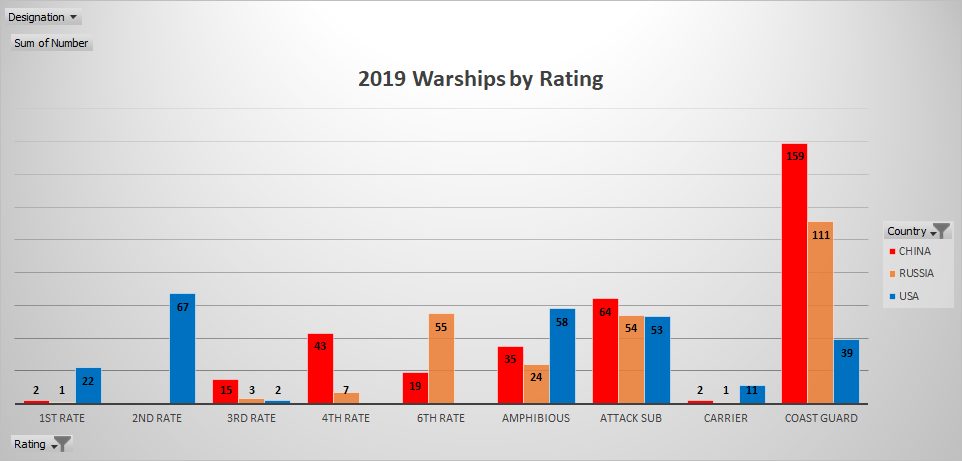
There is a clear USN preference for heavily armed surface combatants compared to potential adversaries. The one Russian Kirov is rated as a first-rate warship, but is barely a blip compared to the U.S. Ticonderoga-class cruisers. The Chinese Type 055 arriving into service will provide China with first-rate warships as well, but still a fraction of the number the USN has. The two U.S. Zumwalt DDGs in 2019 are third-rate ships-of-the-line, but have scores of better armed compatriots compared to the Chinese third-rate vessels. None have a fifth rate combatant (6-20 BFM) unless it is a submarine.
The chart above could spark concern at the rough parity in attack submarines between the U.S., Russia, and China. However, when broken down by type of submarine, the picture changes. The USN relies exclusively on nuclear-powered submarines to provide longer range, greater speed, and more submerged endurance compared to diesel or air-independent propulsion (AIP) submarines. This is because the U.S. plans an “away game” with submarines deployed far from U.S. shores, while Russia and China expect to be using their larger conventional submarine fleets close to home.
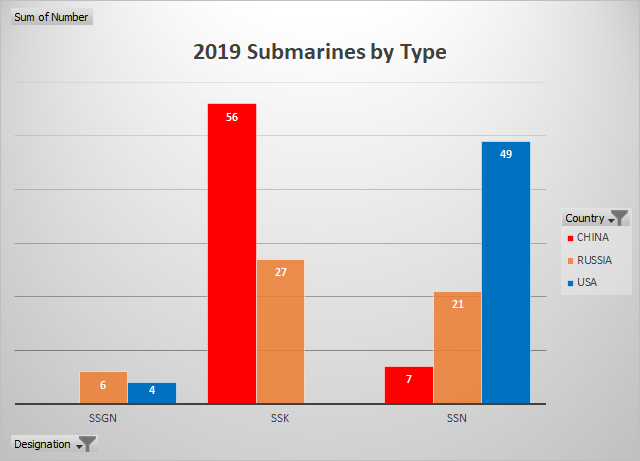
When the metric of BFMs (including torpedoes) is applied, the U.S. is also shown to have a significant lead in subsurface firepower. While the U.S. has fewer SSGNs than Russia, they carry far more missiles per submarine. The three Seawolf SSNs also have an extra-large torpedo load, as do Los Angeles and Virginia class SSNs fitted with vertical launch tubes, to give them more weapons than other subs their size. This allows them to stay in the fight longer before returning to reload. Newer Virginia class submarines will have the Virginia Payload Module (VPM) installed, further increasing their firepower.
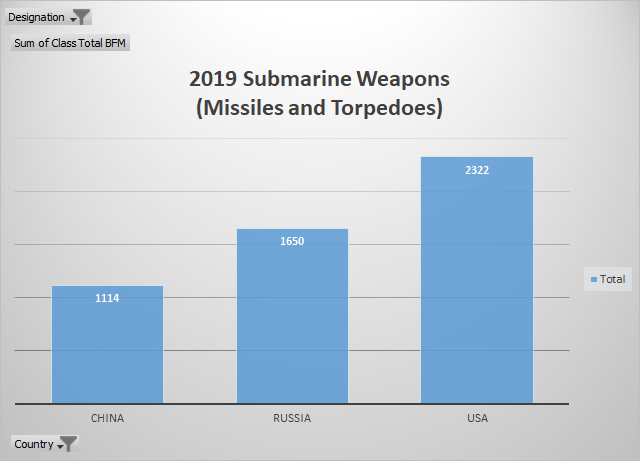
Of course, any single metric will fail to capture the power of a fleet. Informed opinions will differ on the correct offensive and defensive load mix for a warship, or the qualities of a Harpoon ASCM compared to a P-270 Moskit, 3M-54 Club, or YJ-18. Some of these issues are discussed by Alan Cummings in his 2016 Naval War College Review article on Chinese ASCMs in competitive control. In that article, he shows that for anti-ship firepower, U.S. surface vessels are severely over-matched. However, after 2016, VLS options for surface strike (SM-6 and Maritime Strike Tomahawk) have become feasible. Since the mixture of weapons in a VLS tube battery is variable, the number of cells may now provide a better metric than calculations assuming weapons loads. In addition, one must consider crew quality, training, and readiness as components of fleet power. National character and experience as a sea power also come into play. However, all of these qualities are hard to ascribe metrics to, and arms control treaties and analysts focus on measurable and verifiable metrics.
Conclusion
In the end, a fleet must be measured against what it is expected to do. For power projection abroad, a large number of BFMs (or carriers supporting strikes) would be more capable of performing the mission. Close to home, vessels can more easily return to friendly ports to rearm BFMs, so the total at sea may be less important. Even at equal numbers of BFMs, a fleet concentrating them on a smaller number of high-capacity platforms would be less able to control sea-space than a fleet that spread the same number of missiles over a half-dozen combatants. The more distributed fleet would also be more tolerant of losses. Currently, the USN has its power concentrated in high-end warships, be they carriers, large surface combatants, or nuclear submarines. However, this also makes the USN susceptible to major losses, especially if defenses don’t work as well as expected.
The U.S. has a significant lead in BFMs, but also has global commitments which may drastically reduce how many BFMs can be committed to a particular theater. In the western Pacific, the PLAN is rapidly narrowing this lead. As the United States builds towards a 355-ship Navy, it will need to carefully consider the missions required and, in wartime, the firepower required, to accomplish them.
Commander Keith “Powder” Patton is the Deputy Chair, Strategic and Operational Research Dept (SORD) at the Naval War College. The views expressed in this piece are his own and do not represent the official views of the Navy or the Department of Defense.
Featured Image: September 3, 2005. US Navy (USN) Sailors aboard the Arleigh Burke Class (flight I); Guided Missile Destroyer, USS FITZGERALD (DDG 62) inspect the MK 41 Vertical Launching System (VLS) for water to prevent electrical failure. (Photo by: PHAN Adam York, USN)

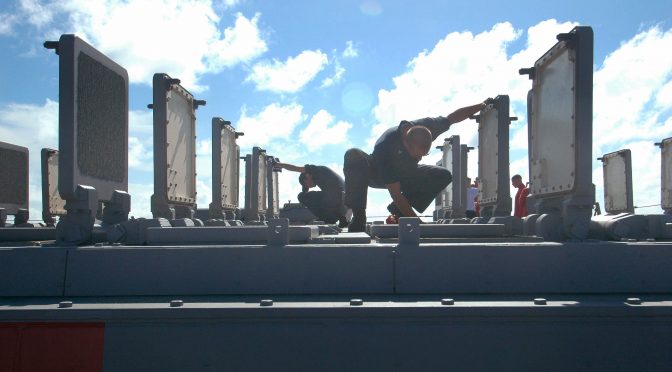
On a ship, sub, and naval plane view, this makes sense. However, when you factor in 6X6, 8X8, and 10X10 Russia and China mobile erector/launcher land fired anti-ship missiles and SAMs, the analytical dynamics change because the USA has no “Mobile Rocket Artillery Forces” attached to its naval inventory for obvious reasons because the Atlantic and Pacific are so vast. We have USMC HiMARS, but that’s not considered long range anti-ship and anti-air that can go beyond 200 miles.
I did consider land based weapons, but getting open source numbers for land based ASBM and ASCM was problematic. Also, looking at it from “naval treaty” lens, shore defenses didn’t count. Also, if we are including land based missiles… land based air could also factor in. So, I tried to keep narrower focus on just the ships and BFMs.
Have VLS barges ever been considered? Could be towed by almost anything or VLS’s stacked, like 40ft 2 TPU containers on freighters. Yes they are probably one use and their gone, but…
I think barges would be too slow and not maneuverable enough to arrive on scene.
The authors make some very good points, but as Krashnovians observes, there are more dimensions to the matter. Most of the USN’s cells are filled with defensive missiles. Even missiles that are dual purpose can’t be fully counted as offensive capability. All three countries also have air forces that have anti-ship capability. Also, in today’s multi-domain operational environment, the relative effectiveness of the battle force network counts for a lot. Missiles need targeting.
The Marines and Army are working to get into the sea control fight and this will be a significant assist – if we can get them into position.
The other issue concerns each side’s ability to “feed the fight.” Unless the initial engagement is strategically decisive (and when has that ever been the case?) the matter of logistics becomes critical.. That is one reason I think turning shipping containers into missile launchers is a good idea. When one is empty, push it overboard and lift another onto the deck. In dreadnought days “staying power” was a key factor and was a function of armor thickness and ship layout. In a missile battle, it will be a function of overall fleet design and logistics.
Counting missile cells leads the authors to some very valid conclusions, but it is far from the whole story. I do not think the USN’s apparent advantage is so great as their numbers suggest.
It is a great article, Keith, and you’re absolutely correct that obtaining accurate count of the stealthy mobile ASCM and ABSM launchers is problematic, hence their purpose of shoot-and-scoot. And of course as you stated, the article’s scope could snowball out of control.
Nonetheless, as Barney stated, with land mobile launchers created for the sole purpose of countering approaching U.S. Naval assets, I do wonder if our BFM advantage has eroded. China and Russia has created great counters to sailing ships over the ocean to attack, and now with hypersonics, drones, stealth aircraft, A2/AD, nuclear icebreakers, diesel subs, etc., the threats are increasing and even rising above what the USN can properly counter.
Nonetheless, again, as you stated correctly, Keith, such further additional weapons exploration and discussion would be beyond the focus of your article and would create a book instead. You present very good information that I didn’t know of.
Like the author’s approach. Perhaps what we need is to follow long term trend of this measure.
Minor point but the USN ship numbers do not include Cyclone class PCs. They were only included in the count in FY2014. https://www.history.navy.mil/research/histories/ship-histories/us-ship-force-levels.html
One of my pet peeves is that USCG ships are not included in the ship count that includes things like the T-ESB, tugs, and salvage vessels. We are supposed to think of the National Fleet.
For my count, USCG were included as Coast Guard, and PCs as unrated vessels. The database includes them. If we put Harpoons back on USCG (or other BFM) they would count towards the tally. You can see the large number of PRC Coast Guard vessels. Perhaps that will be separate article with CMSI (or you 🙂 )
Keith,
I applaud your effort. I must however point out that not all BFMs are created equal. One may consider that the two main factors in inequality could be considered as reach and lethality. For example, while a Heavy Weight Torpedo can be considered lethal, it does not reach near as well as its airborne cousins. As such, in a relative combat power construct it should not carry the same weight as something with equal lethality, and longer reach. Afterall, a force that takes its RCP to the bottom, in effect, had no RCP in the opening argument.
In the Table Top games designed for NWC’s JMO course, an attempt was made to address this by looking at RCP from a capacity and capabilities perspective. Capabilities were binned, in general, as area or point. In addition, lethality was addressed in both P-hit and damage generated. Sensing was also looked at, and outside of situational awareness, was factored in some cases into RCP regarding the ability to shoot or be shot with a modifier to P-hit. In the advanced scenarios, expenditures were also addressed as lost capacity when reload limited capabilities were employed.
This approach provides a similar model to BFM, however expanding on it by differentiating capabilities with reach and lethality, in addition to capacity. The same capabilities and capacities approach was extended to special capabilities such as advanced sensing, EW, or (advanced EW…) cyber. Employment of these capabilities provides, in effect, a “+” or “-” to friendly or adversary sensing or P-hit, which in turn provides an overall impact to RCP by enhancing or degrading capabilities as the case may be. Using this system allows for RCP to be adjusted throughout play as a function of added or removed capacity for the played capabilities. Thus, looking across ‘the board’, one can get a quick sense of RCP in the fight in the capabilities fielded and the quantities each fielding has, in a similar view to BFM based RCP. However, a better understanding is provided by the recognition that not all BFMs are equal.
All that said, in my opinion, one can not look at RCP without looking at the men. Leadership and training matter just as much as the systems employed, and while you noted as hard to assess, an attempt should be made. They deserve a factoring into RCP as well. You can have the best missile in the world, however if you don’t know how, or have the will to use it, again, you are probably going to take it with you to the bottom.
Cheers!
I did note “Informed opinions will differ on the correct offensive and defensive load mix for a warship, or the qualities of a Harpoon ASCM compared to a P-270 Moskit, 3M-54 Club, or YJ-18.” and “one must consider crew quality, training, and readiness as components of fleet power.” 🙂 Concur, and for a game or exercise you have to assign quality values to the quantity. However, to stick to interwar treaty parrallel, not all gun systems were created equal between the powers either (however, a US 16″ gun was probably closer to British and Japanese 16″ gun in specs than modern missiles are to each other today!!). The quality of the missiles would seem to be something that can be changed far faster than adding ships with more tubes.
Wonderful article in its breadth and intellectual stimulation. Love the historical context in evaluating the Washington and London Naval Treaties and their attempts to agree upon a suitable metric to calibrate the maritime balance of power for the 1920’s and 1930’s. What is compelling about history is that despite the omnipresence of the “battleship theory” of naval warfare (perhaps shaped in large part by Trafalgar, Tsushima and Jutland), the advent of airpower first at Taranto and then unfortunately at Pearl Harbor (followed by the losses of the HMS Repulse and Prince of Wales) represented a major technological and strategic “disruption” that upended many decades of naval thinking.
Perhaps I am overly worried, but I feel that emerging technologies represent a real challenge to existing naval doctrine as AI-enhanced drones, unmanned underwater systems, and ASBMs begin to shape a new type of swarm-intelligence enabled revolution that seriously threatens high-capacity surface combatants in the near future. Even more foreboding is the likely arrival of “kamikaze-drones” that represent the democratization of precision-guided munitions, especially in an A2/AD context.
There is little doubt that the USN still possesses the overwhelming experience, leadership, training, and technology that dominates the oceans. However, given the overstretch in global commitments and budgets that it faces, I am afraid we might be in for a Crecy or Poitiers moment if we are not careful.
A great piece that will continue to stimulate interested minds!
This is a great article, as it highlights the minimal utility in counting hulls as our politicians like to do. The counting of BFM’s is a great step in the righ direction. While I understand the potential for unlimited expansion of the scope in this comparision, I would argue that counting BFM’s is only equivilant to counting the number of guns of old. Counting Defensive missiles may equate to armour and must be considered. More importantly missile range and capability must be compared and may be equilvilant to the previous measure of gun caliber. Assuming equal ISR, which may be reasonable if the fight is in their backyard, we are being out-sticked. All the BFM’s in the world do not count if you are dead before you get within firing range.
Concur. The database does have the self defense missiles in it, but I was sticking with Work’s definition for a limited scope article. I also built the database at 10yr intervals (78, 88, 98, 08, 18) to examine historical trends of multiple nations besides ones in article. China had a dip 88-98, an steady growth since then compared to USN which has been relatively static over the decades.
I view this article as a contributor for future naval programs and shipbuilding. Ironically, the USN foresaw this with the Arsenal Ship (none built), missiles in cargo containers, Virginia Payload Module, and the SSGNs.
Does this mean we need Arsenal Ships and VLS on Amphibs to affect “Distributed Lethality” and “Distributed Maritime Operations” to increase BFM VLS cell count? That was the plan…then again…what happened if these plans weren’t implemented?
Bring on the Sea Gryphon.
https://interestedamateur.blogspot.com/2019/03/bring-on-sea-gryphon.html?m=1
I like the idea of “Strike-Miles” as an aggregate offensive metric for fleet architecture comparisons.
https://digital-commons.usnwc.edu/cgi/viewcontent.cgi?article=1143&context=nwc-review
Strike-miles (SM) = warhead weight (pounds/1,000) × range (nm)
It incorporates the notion of throw-weight as well as range into the equation.
Obviously still a vast simplification, but it does clearly show the value of Tomahawk vs NSM.
Tomahawk
Range: 900 nmi
Warhead: 1,000lbs
SM: 900
NSM
Range: 100 nmi
Warhead: 276lbs
SM: 27.6
One could calculate Strike-Miles for other missiles, torpedoes and aircraft across all cells and aviation spots to come up with a composite, fleet, Strike-Mile “score” (guesstimating at composition of VLS cell load outs).
Aircraft Strike-Miles should be aggregated over a certain number of sorties. (e.g. X days times Y sorties per day times Z bombs per sortie) The longer the duration, the higher aircraft will be rated vs missiles (and the more things like attrition and replenishment will factor in).